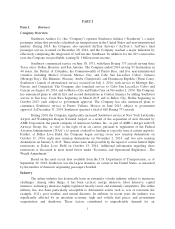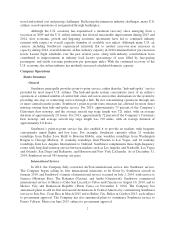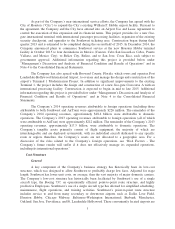Southwest Airlines 2014 Annual Report Download - page 19
Download and view the complete annual report
Please find page 19 of the 2014 Southwest Airlines annual report below. You can navigate through the pages in the report by either clicking on the pages listed below, or by using the keyword search tool below to find specific information within the annual report.• implementation of new engine start procedures to support the introduction of new
single engine taxi procedures;
• adjustment of the timing of auxiliary power unit starts on originating flights to reduce
auxiliary power unit usage;
• fuel planning initiatives to safely reduce loading of excess fuel;
•Evolve aircraft cabin interior retrofit featuring lighter seats;
• reduced aircraft engine idle speed while on the ground, which also increases engine
life;
• galley refresh with dry goods weight reduction;
• Company Optimized Routes (flying the best wind routes to take advantage of tailwinds
or to minimize headwinds);
• improved flight planning algorithms to better match aircraft Flight Management
System (flying at the most efficient altitude);
• substitution of Pilot flight bags with lighter Electronic Flight Bag tablets; and
• Real Time Descent Winds (automatic uplink of up-to-date wind data to the aircraft
allowing crews to time the descent to minimize thrust inputs).
The Company has also participated in Required Navigation Performance (“RNP”) operations
as part of the FAA’s Performance Based Navigation program, which is intended to modernize the U.S.
Air Traffic Control System by addressing limitations on air transportation capacity and making more
efficient use of airspace. RNP combines the capabilities of advanced aircraft avionics, Global
Positioning System (“GPS”) satellite navigation (instead of less precise ground-based navigation), and
new flight procedures to (i) enable aircraft to carry navigation capabilities rather than relying on
airports; (ii) improve operational capabilities by opening up many new and more direct airport
approach paths to produce more efficient flight patterns; and (iii) conserve fuel, improve safety, and
reduce carbon emissions. Southwest began conducting GPS approach procedures during the first
quarter of 2010, completed RNP training of nearly 6,000 pilots in November 2010, and commenced
RNP procedures in revenue service in January 2011. By the end of 2014, Southwest had conducted
over 18,000 RNP approaches, including approximately 4,500 in 2014. Southwest must rely on RNP
approaches published by the FAA, and the rate of introduction of RNP approaches continues to be
slower than expected, with fuel efficient RNP approaches currently available at only 46 airports. In
addition, even at airports with approved RNP approaches, the clearance required from air traffic
controllers to perform RNP approaches is sometimes not granted. Southwest continues to work with
the FAA to develop more RNP approaches and to modify air traffic control rules to support greater
utilization of RNP.
New Livery and Branding and Aggressive Promotion of the Company’s Points of
Differentiation from its Competitors
In September 2014, the Company launched a new visual expression of its brand by introducing
a new Heart aircraft livery, airport experience, and logo. From a financial perspective, the Company
intends for this launch to remain cost-neutral by using a phased roll-out across both its fleet and its
network. Aircraft already in the Company’s fleet are scheduled to receive the newly painted livery
11
























